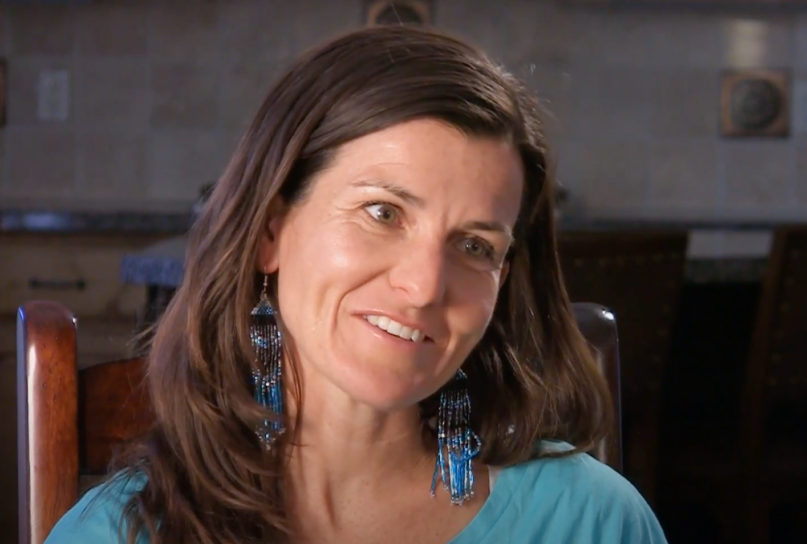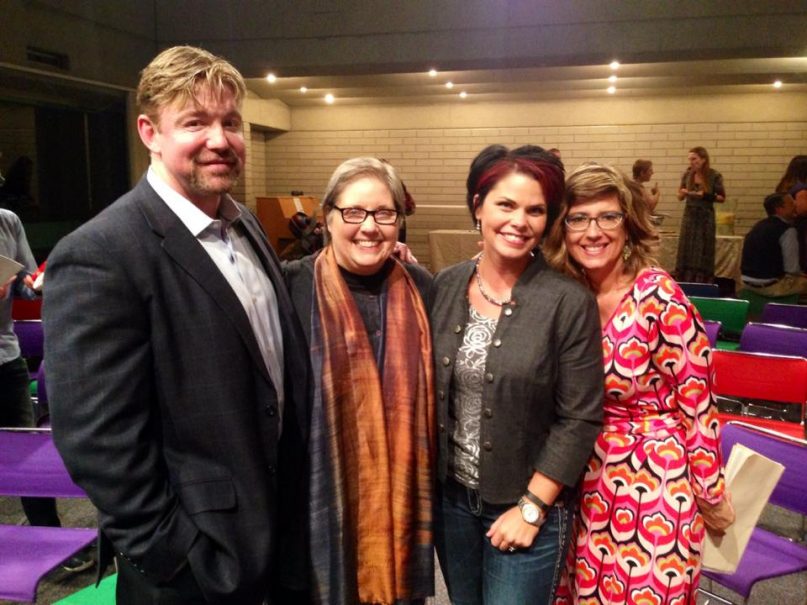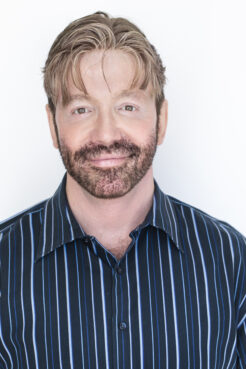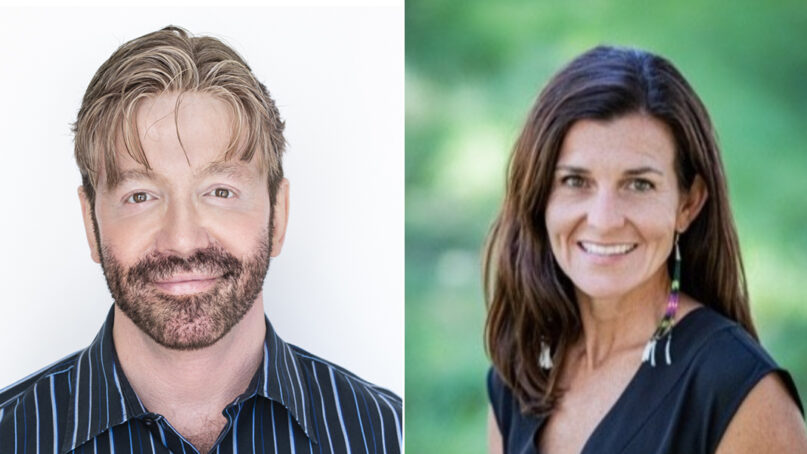(RNS) — Just over a decade ago, The Church of Jesus Christ of Latter-day Saints was having a “moment” in the U.S.
Mitt Romney was running for president, the “Book of Mormon” musical was a hit Broadway show, and the “I’m a Mormon” campaign lit up billboards on Times Square.
Also, Joanna Brooks and Mitch Mayne were showing a public face to Mormonism that hadn’t been widely seen before — a progressive, feminist, LGBTQ-allied stance in an otherwise deeply conservative religion.
Brooks’ memoir “Book of Mormon Girl,” initially self-published, was picked up by a major New York publishing house in 2012 and garnered lots of media, including an interview on “The Daily Show” with Jon Stewart.
And Mayne, one of the first openly gay men to serve as a ward executive secretary*, was a regular in the media as well, speaking out for LGBTQ equality in The New York Times and Huffington Post.
In more recent years, both retreated from those very public spaces. I recently sat down with them over Zoom to discuss where they are now and the changes they’ve witnessed in the church — indeed, the changes they helped inaugurate.
This has been edited for length and clarity. (And by way of full disclosure, both Mitch and Joanna are friends of mine.) — JKR
I want to know your standout experiences from that “Mormon moment.” Joanna, let’s start with you.
Joanna Brooks: There were so many. But personally, one of the most powerful moments for me was doing two hours back-to-back on BBC Radio with the church’s official spokesman at that time. The host would pivot back and forth between us. It felt like my background as someone who has lived the faith and as a scholar of religion allowed me to be in the room as a sort of translator; the Church was struggling so hard to make itself intelligible to the outside world at that time.
I remember how uncomfortable it was for many LDS people to have the media feature unofficial perspectives like mine. Once I was giving a talk at the University of Southern California (USC), and this man confronted me from the first row, very pointedly: “You understand that you don’t speak for the church. The only people that speak for the church are the guys on North Temple and the Church Office Building.” True! Obviously! The idea that anyone besides an official Church spokesperson could represent Mormon experience broadly was still so new, and maybe threatening.

Author Joanna Brooks during a media interview in 2012. Screen grab, Mormon Stories.
Mitch, how would you characterize that time in your life?
Mitch Mayne: It was fun, it was energizing, it was an honor. And it was scary as heck. I’d had a fair amount of experience already being outspoken in the LGBT community as well as in my career. I had been working for a Fortune 100 blue chip who manages their brand very tightly, and I spent years managing that brand. And so I knew the minute I was called to that I had to think of myself as that brand. There was caution around what I would say and do, because I needed to walk the middle ground. Change doesn’t happen in either extreme; change happens in the middle.
Some of the most amazing moments to me were, I mean, first and foremost, the Family Acceptance Project, which is the gold standard of evidence-based research for LGBT youth suicide prevention. They created materials specific to Mormon families because we had such a problem with Mormon LGBT suicide. The outcome of that was amazing because it actually taught parents how to relate to their LGBT child beyond the binary of either “you are straight or I reject you.” Erasing that dichotomy was a huge step forward.
The other thing was seeing how Mormons started becoming involved in Pride. We have annual Pride marches to this day where Mormons are leading contingents with their baby strollers, babies on shoulders. That was all so amazing. I’m actually getting chills just talking about this stuff.

Left to right, Mitch Mayne, Dr. Caitlin Ryan, Wendy Montgomery and Diane Oviatt pose for a photograph during the showing of a documentary about a Mormon family whose 13-year-old son came out as gay. 2014 Photo courtesy of Mitch Mayne, RNS Archives.
Joanna, you talked about the challenges of there not being many “unauthorized voices” in that time. Did you receive pushback from the Church?
Joanna Brooks: There is a history of famous Mormon feminist excommunications, so everyone assumed I did. But I really didn’t. I developed a very intuitive personal, prayerful approach to the work. I intuited that I should not try to talk to the Church Office Building, but rather to other Mormon people. I never tried to imagine the leaders as a potential audience, ever. I did not want to be on their radar as saying anything that seemed I was trying to correct or manage the Brethren.
Still, I knew the general authorities were aware of me. Someone on Facebook messaged me that Dallin Oaks had talked about me by name over the pulpit during their stake conference in Arizona, after I was on an NBC News program; he said I was wrong about women and the priesthood. The Church also sent out a survey to thousands of members trying to gauge (among other things) how many people were reading my column in “Religion Dispatches.” The internet was so new, they assumed that if something was published online, it must have enormous reach.
In addition to being very intuitive and careful, I tried to get out of the crosshairs by training other women to do the work as soon as I possibly could. To get that much attention is a very powerful drug, and it’s human to want to hang onto it and do it forever. But I wanted to develop capacity among Mormon women so none of us could be singled out. So I started teaching others how to talk to the media, and consciously forwarding media requests to them.
Mitch Mayne: I’m of the same mindset as Joanna. That time was absolutely amazing, but I too got the death threats. I would get the angry emails — not only from Mormons, but also from the LGBT community. I was told I was betraying my sexual orientation.
How I walked away from it was beginning to understand that I had not allowed Mormons to tell me how to be gay, and I would not allow the LGBT community to tell me how to be Mormon. That part of my identity is very much mine, and the only opinion of me that matters more than my own is that of my Savior. That was true then, and that is true now.
I did not want to stay in that spotlight forever. And I was extremely grateful that there became a chorus of divergent voices. In 2012, if you Googled “gay Mormon,” I was it; I was the only one out there. But if you Google that now, there’s thousands of hits.

Joanna Brooks today. Courtesy photo
Joanna Brooks: I will say I had a really, really good bishop at the time. All this media stuff was going down, and he just didn’t let anything ruffle him.
But a few years later we did have a bishop who took out some resentment on my then 12-year-old daughter during a temple recommend interview — she wanted to do baptisms for the dead. He put her on the spot from the beginning. Then he got to the point in the temple recommend interview where he asked her if she was affiliated with any groups opposed to the church. And she said no; I mean, this child is 12! And he said, “Well, that’s not true because your dad’s Jewish. And we all know that Jews are opposed to the gospel of Jesus Christ.” And she looked at him and explained that no, they’re not opposed. My child’s an expert in how to know God in two languages.
It would have been fine if he didn’t want her to go to the temple for this reason or that, but he attacked a core part of her being. And he did so on very theologically specious grounds. So I said we could stop the interview, but she wanted to continue. She held on and finished the whole thing. Tough little girl. And then we left, both of us crying, and I said, “I will never do that to you again.” And I have never put my children in a position with a priesthood holder since then. I will not have grown men acting unaccountably because the fact of people like me and Mitch is so unsettling to them. I knew it was not about my daughter; it was about me.
Mitch, did you have any experiences with leadership roulette that were painful?

Mitch Mayne today. Courtesy photo
Mitch Mayne: Oh, roulette was the bulk of my experience. I call it institutional schizophrenia. I still see that today. Most of what I do today is not on a really high public level, but a one-on-one level. I will get the calls from a bishop or a stake president saying, “I really want to help my congregation be better at the LGBT thing. What do I do?” And I’ll say, “Fortunately, we created this training program. I’m happy to send you that and help you understand how to present it.”
But I also get agonizing stories, like a 77-year-old stake president who confessed to me that he was gay and had been gay all of his life. He had grandkids and was expecting great-grandkids, and he wanted to know if he had wasted his life. I can’t answer that. I see a lot of pain from people trying to live someone else’s version of their life.
Where are you now with the church? And if you don’t feel comfortable answering that question, it’s okay.
Joanna Brooks: I do not attend. I am a member. My faith continues. I am every day trying to find new ways to express that and to express my love and gratitude for this amazing experience of being a Mormon at this time on earth. And really, how Mormon is that? But LDS Church buildings are not a place where I find myself really able fully to talk to God on the terms presented.
Mitch Mayne: I can echo that. I’m probably a little more closely involved than Joanna. During COVID, I kind of stopped going, like we all did. I haven’t really gotten back to regular attendance. There’ve been times in my life when I have gotten way more from the church than I have been able to give to it. I am now in a phase where I get less from the church, but I’m able to offer more to it. But I find the institutional schizophrenia a little wearying.
I am always going to be Mormon. Mormonism is my first language when it comes to speaking to God. But my version of God no longer fits in the Mormon box. It doesn’t fit in the Buddhism box or the Jewish box or the Muslim box. It’s far more expansive, and I’m immensely happy.
Correction 5/16/23: An earlier version of this story described Mitch Mayne as the first openly gay man to serve in a bishopric. That is not accurate. The executive secretary position is not considered a part of the bishopric, although the secretary attends their meetings and helps with other bishopric activities. For more information, see the Church Handbook (section 6.3), and this 2011 description from By Common Consent.
Update 2/8/24: A photo and quotation were removed from this story at the request of one of the interviewees.
Related content:
In Mormon Utah, LGBTQ Pride celebrations meet a desperate need
Mormon feminists mark 50 years of speaking up and speaking out






